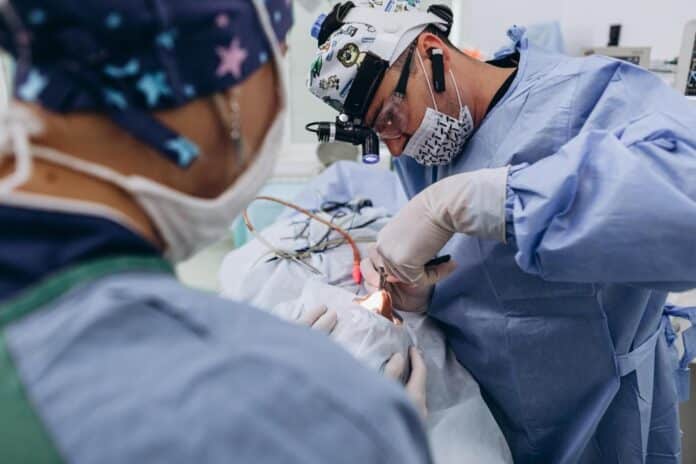A small nanosurgical instrument far thinner than a human hair may be able to explain some of the side effects of some cancer therapies. Researchers from the University of Leeds created this unique tool. It’s like a high-tech needle to study cancer cells in real-time. This is important because it could help doctors make better cancer drugs.
The device features two microscopic needles that draw blood from and inject into a cell simultaneously. Because of this, it can be used for a wide range of purposes. Also, because of this tool’s semi-automated characteristics, using it is now considerably faster. This allows researchers to gather data from many individual cells quickly and accurately.
Researchers usually destroy the single cells they are studying. As a result, they are limited to viewing the cell before or after treatment.
But this new device is different. It can take small samples from a living cell repeatedly while it’s being treated for cancer. This lets researchers see how the cell reacts to the treatment over time without harming it.
Dr. Lucy Stead, an expert in brain cancer biology at Leeds’ School of Medicine, said, “This technology will help us understand cancer better than ever. With this new understanding, we can develop better ways to fight all types of cancer.”
Researchers from different fields tested how cancer cells resist chemotherapy and radiotherapy. They focused on glioblastoma (GBM), the most lethal kind of brain tumor, which responds well to treatment.
Dr. Lucy Stead, a brain cancer biology expert at the University of Leeds, considers the recent breakthrough significant because it allows for the first time to directly observe how cancer cells evolve post-treatment rather than relying on assumptions.
She hopes that this development will lead to a better understanding of cancer and the development of more potent treatment plans. Highlighting the urgent need for improved therapies, particularly for glioblastoma, where survival rates have stagnated for two decades, Dr. Stead underscores the tumors’ adaptive nature as a significant challenge.
The new technology makes it possible to monitor these cells in real-time, which could help us understand their behavior and find strategies to overcome their resistance to therapy. This kind of monitoring was previously impossible with current techniques.
Dr. Stead leads a research group at the Leeds Institute of Medical Research focused on curing GBM brain tumors. She believes the new technology could be a game-changer for treating this cancer, which currently has no cure. The research was funded mainly by The Brain Tumour Charity, supported by former Leeds footballer Dominic Matteo, who underwent brain tumor surgery in 2019.
Dr. Simon Newman from The Brain Tumour Charity explains that glioblastoma cells often become resistant to treatment, leading to the tumor returning. The new technology allows researchers to study how this resistance develops, offering hope for better treatments in the future.
The study involved researchers from different departments at the University of Leeds and the Earlham Institute, Norwich. They examined individual GBM cells for 72 hours using a tiny nanosurgical tool controlled by robotic software. This device allowed them to take samples repeatedly and study how the disease progressed in each cell.
Understanding why some cells survive treatment while others don’t is crucial for finding a cure. Lead author Dr. Fabio Marcuccio from Imperial College London, who conducted the research at Leeds, emphasized the importance of interdisciplinary teamwork in tackling cancer challenges.
GBM cells are highly adaptable, which makes treating them difficult. Learning how they adapt could help prevent cancer from returning, offering hope for patients like Camilla Hawkins, who was diagnosed with GBM in 2022.
The University of Leeds’ Dr. Paolo Actis, a specialist in bio-nanotechnology, has been creating the nanobiopsy instrument for almost 15 years. He stated that the tool’s expanded capabilities offer substantial advantages compared to its initial design.
The nanobiopsy tool can identify these cells, allowing researchers to study how they change after treatment. Understanding these changes is crucial for developing drugs to prevent cancer from returning. Dr. Stead emphasized the importance of further research using this technology on more samples, both in the lab and humans, but acknowledged that it has already provided valuable information.
In conclusion, the University of Leeds researchers’ nanosurgical instrument holds out hope for significant advancements in cancer treatment. This technology provides valuable insights into how cancer responds to treatment by allowing precise analysis of individual cancer cells. With further research and development, this tool may lead to more effective treatments and improved outcomes for cancer patients.
Journal reference:
- FABIO MARCUCCIO, CHALMERS C. CHAU et al., Single-cell nanobiopsy enables multigenerational longitudinal transcriptomics of cancer cells. Science Advances. DOI: 10.1126/sciadv.adl0515.
